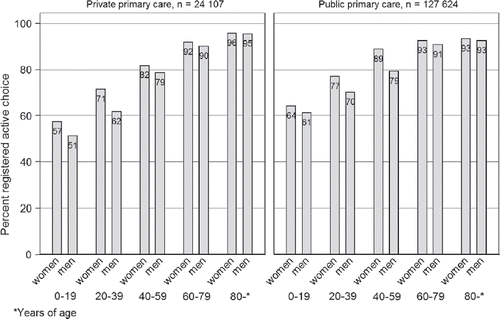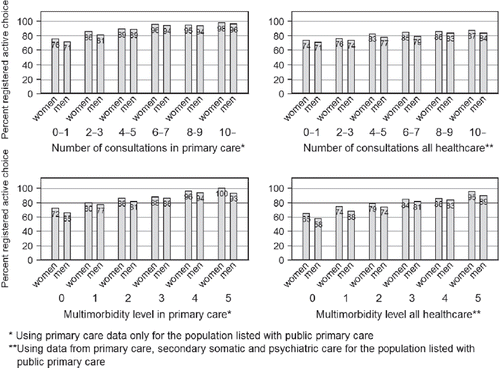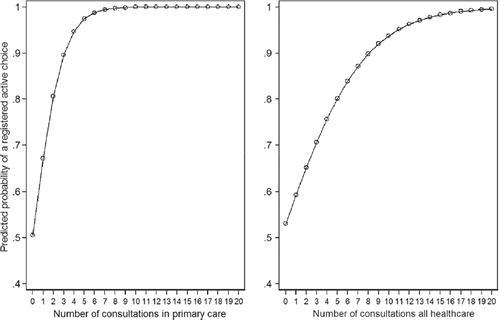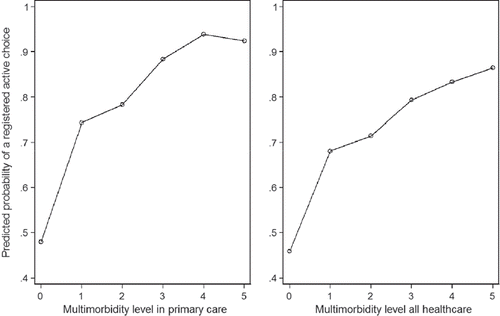Abstract
Objective. To study the associations between active choice of primary care provider and healthcare utilization, multimorbidity, age, and sex, comparing data from primary care and all healthcare in a Swedish population. Design. Descriptive cross-sectional study using descriptive analyses including t-test, correlations, and logistic regression modelling in four separate models. Setting and subjects. The population (151 731) and all healthcare in Blekinge in 2007. Main outcome measure. Actively or passively listed in primary care, registered on 31 December 2007. Results. Number of consultations (OR 1.31, 95% CI 1.30–1.32), multimorbidity level (OR 1.69, 95% CI 1.67–1.70), age (OR 1.03, 95% CI 1.03–1.03), and sex (OR for men 0.67, 95% CI 0.65–0.68) were all associated with registered active listing in primary care. Active listing was more strongly associated with number of consultations and multimorbidity level using primary care data (OR 2.11, 95% CI 2.08–2.15 and OR 2.14, 95% CI 2.11–2.17, respectively) than using data from all healthcare. Number of consultations and multimorbidity level were correlated and had similar associations with active listing in primary care. Modelling number of consultations, multimorbidity level, age, and sex gave four separate models with about 70% explanatory power for active listing in primary care. Combining number of consultations and multimorbidity did not improve the models. Conclusions. Number of consultations and multimorbidity level were associated with active listing in primary care. These factors were also associated with each other differently in primary care than in all healthcare. More complex models including non-health-related individual characteristics and healthcare-related factors are needed to increase explanatory power.
Active listing in primary care has implications for individual health as well as healthcare systems.
Frequent attenders, patients with a high multimorbidity level, women, and the elderly choose the primary care provider more often than expected.
The association of number of consultations and multimorbidity level with active listing in primary care is stronger when using only primary care data.
Number of consultations and multimorbidity level has about 70% explanatory power for active listing in primary care.
Introduction
The importance of primary care increases when the focus in healthcare changes from patients with single illnesses to persons with complex health problems. Within populations good relations between patients and primary care contribute to more adequate care, trust, and better health [Citation1,Citation2]. It has been shown that strategies to encourage patient–doctor relations increase availability of care and also the risk of individuals not feeling the need for continuous relations in primary care receiving insufficient care. Continuity is particularly valued for more serious and psychological problems [Citation3–6]. When asked, a majority of participants in Swedish surveys wanted to choose their primary care provider [Citation7].
Choices in healthcare are affected by a variety of factors related to both individuals and healthcare [Citation8]. How patients relate to primary care is linked to choice of primary care provider [Citation9–14]. Differences in individual preferences and options can be explained using trust and other constructs related to theories on social capital [Citation15]. According to theories on decision-making, choice behaviour in healthcare is complex, due to either not using all information available or not having enough information [Citation16].
In Sweden, healthcare is managed by county councils, financed by taxation, and with low co- payment for health services. Primary care is organized in group practices with general practitioners (GP) and multidisciplinary teams. Choice of primary care provider (listing) was introduced as a concept of patient empowerment, mandatory since 2010 [Citation17]. In Blekinge, a county in south-eastern Sweden, listing was introduced in primary care in 2004. Passive listing with a nearby clinic was registered, until active listing was registered by the individual.
Listing is part of the structure that affects processes and outcomes of primary care systems. Primary care providers work with patient lists formed by repeated individual choices. Robust knowledge regarding these choices is needed to improve primary care systems. Most previous studies are based on reported data, not focusing on choice behaviour. We use patient records from primary care and all healthcare in a population, comparing the explanatory power of number of consultations and multimorbidity level in four models. This study contributes by linking choice behaviour and individual characteristics, comparing primary care with all healthcare. The aim is to explore the associations of healthcare utilization, multimorbidity level, age, and sex with active listing in primary care, comparing data from primary care with data from all healthcare.
Material and Methods
Study Population and Design
In 2007, Blekinge had 151 731 inhabitants. The average age was slightly higher (42.7 years) and there were more males (50.5%) compared with all of Sweden (41 years and 49.7%) [Citation18]. All healthcare, including two hospitals and five psychiatric clinics, was funded by the county council. Primary care (90 GPs) comprised 12 public and 13 private clinics. Listing in primary care was introduced in 2004. Funding, allocated at clinic level, favoured listing with clinic rather than GP. Passive listing was registered with a nearby clinic, until changed to active by the individual. Active listing could be changed monthly, and children followed their mother's choice.
Data on healthcare utilization and morbidity were collected from electronic patient records, not available from all private providers. This study was approved by the Regional Ethical Review Board at Lund University (application no. 2010/314). The alternative of not participating was possible, but was not used by any in the study population.
Outcome and Explanatory Factors
Outcome was registered active or passive listing in primary care on 31 December 2007. Listing with individual GP was not analysed.
Healthcare utilization was measured as number of consultations with a physician (categorized into 0–1, 2–3, 4–5, 6–7, 8–9 and > 9) during 2007. Multimorbidity level was measured from patient records for 2007 using the Johns Hopkins Adjusted Clinical Groups Case Mix System (ACG), a summary measure of morbidity burden. All individuals were assigned to one of six levels called resource utilization bands (RUBs), ranging from 0 (no need of healthcare services) to 5 (very strong need of healthcare services) [Citation19–22]. Number of consultations and multimorbidity level were analysed separately for primary care and all healthcare, including primary care as well as secondary somatic and psychiatric care. Due to different electronic patient record systems, individual data on number of consultations and morbidity in private primary care were not reliable, hence not used to compare primary care and all healthcare. Age and sex were used as complementary factors in all models, age in 20-year strata.
Statistical Analysis
Descriptive analyses including t-test, correlations, and logistic regression modelling using Akaike's Information Criterion (AIC) for model comparison were performed with STATA version 13.0 (Stata Corporation, Texas, USA). The population of Blekinge (151 731) was used when complete data were available. Private and public primary care was compared using available data on age and sex. Four separate models for number of consultations and multimorbidity level were used, when data from primary care were compared with all healthcare. Two models with number of consultations, multimorbidity level including interaction, age, and sex were then used to explore interaction.
Results
Blekinge county had 151 731 inhabitants on 31 December 2007. All were passively or actively listed in primary care, 127 624 with public and 24 107 with private primary care. A total of 98 600 (53% women, 47% men) were actively listed with a primary care clinic and 60 921 of them also chose a personal GP. A total of 63.2% of those listed with public primary care and 74.5% of those listed with private primary care were actively listed. Elderly patients were more frequently actively listed than younger patients (OR 1.03, 95% CI 1.03–1.03), in both public and private primary care (). Individuals with many consultations (OR 1.31, 95% CI 1.30–1.32) or a high multimorbidity level (OR 1.69, 95% CI 1.67–1.70) in all healthcare were more likely to be actively listed (). Individuals actively listed were on average 14 years older, had 40 % more consultations and 30% higher multimorbidity level and were more likely to be female than those passively listed (each difference p < 0.001).
figure 1. Percentage of the population in blekinge (n = 151 731) with a registered active choice of primary care provider in 2007 for individuals listed with private or public primary care.

Figure 2. percentage of the population with a registered active choice of primary care provider in 2007 according to number of consultations and multimorbidity level, comparing primary care and all healthcare for the population listed with public primary care in blekinge (n = 127 624).

For those listed with public primary care, number of consultations had a stronger association in primary care (OR 2.11 for continuous factor, 95% CI 2.08–2.15) with active listing than in all healthcare (OR 1.31, 95% CI 1.30-1.32), adjusting for age and sex. Predicted probability of active listing was increasing most for the first 10 consultations then tapered off, in primary care as well as all healthcare ().
figure 3. predicted probability of a registered active choice of primary care provider according to number of consultations in primary care and all healthcare, controlling for age and sex, in the population listed with public primary care (n = 127 624) in blekinge 2007.

For being listed with public primary care the overall association of multimorbidity in primary care (OR 2.14, 95% CI 2.11–2.17) had a stronger association with active listing than multimorbidity in all healthcare (OR 1.70, 95% CI 1.69–1.72), adjusting for age and sex. Multimorbidity level predicted active listing, significantly (p < 0.001) increasing for RUB 0-4, both in primary care and all healthcare ().
figure 4. predicted probability of a registered active choice of primary care provider according to multimorbidity level measured in primary care and all healthcare, controlling for age and sex, in the population listed with public primary care (n = 127 624) in blekinge 2007.

The correlation between multimorbidity level and number of consultations, in six categories, was 62% in primary care and 68% in all healthcare. Comparing primary care and all healthcare, categorized consultations had a 72% correlation and multimorbidity level a 77% correlation.
The four separate models, including number of consultations, and multimorbidity level using data from primary care and all healthcare, gave similar predictive power of about 70% to correct classification of listing in primary care. Models including both number of consultations and multimorbidity level did not improve the results ().
Table I. Modelling multimorbidity and number of consultations, controlling for age and sex, on active listing with public primary care in Blekinge 2007 (n = 127 624), comparing data from primary care and all healthcare.
Discussion
Our aim was to explore the associations of healthcare utilization, multimorbidity, and active listing in primary care. We found that both number of consultations and multimorbidity level predicted registered listing in primary care, which had not been shown in a Swedish population before. Number of consultations and multimorbidity level were related and their predictions were similar.
It was confirmed that individual factors, such as healthcare utilization, multimorbidity level, age, and sex not only influenced patient attitudes towards continuity, but also predicted choice of primary care [Citation23,Citation24]. Number of consultations and multimorbidity level had a similar association with listing in primary care, stronger when only using primary care data. As expected, the correlations between number of consultations and multimorbidity level indicated common latent factors. In primary care those correlations were weaker, indicating that the latent factors worked differently in primary care than in all healthcare.
Modelling the associations of number of consultations, multimorbidity level, and listing in primary care, adjusting for age and sex, gave four separate models with similar explanatory power. Considering that active listing in primary care is a complex choice affected by both individual factors and healthcare system factors, it is expected that these models need to include more individual characteristics and factors related to healthcare in order to increase their explanatory power and precision.
In Sweden, data from health registers could be used to link choice behaviour and individual characteristics. Reliable data and an understandable listing system were available for the population of Blekinge. The listing system was almost the same as the mandatory listing system legislated in 2010 and allowed generalization within a Swedish context [Citation25]. Some bias in registered listing remained since 2004. In public primary care established patient–-doctor continuity was protected by assigning an active listing with that GP, including clinic. Patients (6581) with the same choice in 2007 were treated as actively listed. Some private primary care clinics (8498 listed) were allowed to list all patients with previous consultations as actively listed, regardless of established patient continuity, which was noticed when healthcare was needed. All patients registered in private primary care were excluded when comparing primary care with all healthcare due to missing data.
Recent Swedish surveys have investigated reported choice of primary care provider. Glenngård et al. reported (response rate 50%, bias towards high educational level and high self-rated health) choice of primary care clinics as 61% with proportions differing with regard to age, municipality, and occupation, but not with regard to self-reported health status, sex, living conditions, county, or education [Citation23]. In a discrete choice experiment, with response rate 58%, Hjelmgren and Anell found that older individuals and individuals in poor health preferred a GP, and individuals working or living at a greater distance from a hospital preferred a primary care team [Citation24]. We confirmed that individual health-related factors were related to active listing in primary care.
Zielinski et al. studied the passively listed population, when a clinic was established in Blekinge in 2005. One year later, older individuals and those with a higher multimorbidity level were more likely to be registered as actively listed [Citation26]. We confirmed that frequent attenders, people with high multimorbidity level, the elderly, and women more often were actively listed.
Both number of consultations and multimorbidity level are related to morbidity burden and the wider concept of patient complexity [Citation27]. We showed that they are related constructs, working differently in primary care than in all healthcare, similarly affecting listing in primary care.
Conclusions and Perspectives
Number of consultations, multimorbidity level, age, and sex were associated with active choice of primary care provider, as expected from surveys.
Listing in primary care had a stronger association with number of consultations and multimorbidity level using primary care data than using data from all healthcare. Number of consultations and multimorbidity level were correlated. Their different relations in primary care and all healthcare remain to be investigated.
Modelling number of consultations and multimorbidity level gave four separate models with similar explanatory power for active listing in primary care. More complex models are needed to increase the explanatory power and precision.
Including individual characteristics such as socioeconomics, geography, and social capital in the models should be explored. The latent factors underlying the observed correlation between number of consultations and multimorbidity level should also be explored using structural equation modelling, and the different correlations in primary care and all healthcare fully investigated. Choices of primary care provider ought to be studied according to theories on complex choices and with constructs like patient satisfaction, trust, and attachment. The influence of characteristics of different primary care clinics also needs to be further investigated.
Acknowledgements
This study received financial support from Blekinge County Council.
The authors are indebted to Stephen Gilliver, Lund University, and Lise Stark, University of Southern Denmark, for their expertise and invaluable advice in proofreading the manuscript.
Declaration of interest
The authors report no conflict of interest. The authors alone are responsible for the content and writing of the paper.
References
- Starfield B, Shi L, Macinko J. Contribution of primary care to health systems and health. Milbank Q. 2005;3:457–502.
- Starfield B, Lemke KW, Bernhardt T, Foldes SS, Forrest CB, Weiner JP. Comorbidity: Implications for the importance of primary care in “case” management. Ann Fam Med. 2003; 1:8–14.
- Lambrew JM, DeFriese GH, Carey TS, Ricketts TC, Biddle AK. The effects of having a regular doctor on access to primary care. Med Care. 1996;2:138–51.
- Mohseni M, Lindstrom M. Social capital, trust in the health-care system and self-rated health: The role of access to health care in a population-based study. Soc Sci Med. 2007;64:1373–83.
- Schers H, Webster S, van den Hoogen H, Avery A, Grol R, van den Bosch W. Continuity of care in general practice: A survey of patients’ views. Brit J Gen Pract. 2002;52: 459–62.
- Turner D, Tarrant C, Windridge K, Bryan S, Boulton M, Freeman G, et al. Do patients value continuity of care in general practice? An investigation using stated preference discrete choice experiments. J Health Services Res Pol. 2007; 12:132–7.
- Rosen P, Anell A, Hjortsberg C. Patient views on choice and participation in primary health care. Health Policy. 2001;55:121–8.
- Arora R, Singer J, Arora A. Influence of key variables on the patients’ choice of a physician. Qual Manag Health Care. 2004;3:166–73.
- Lindström M, Axén E, Lindström C, Beckman A, Moghaddassi M, Merlo J. Social capital and administrative contextual determinants of lack of access to a regular doctor: A multilevel analysis in southern Sweden. Health Policy. 2006;79:153–64.
- Heje HN, Vedsted P, Sokolowski I, Olesen F. Patient characteristics associated with differences in patients’ evaluation of their general practitioner. BMC Health Serv Res. 2008; 8:178.
- Vedsted P, Heje HN. Association between patients’ recommendation of their GP and their evaluation of the GP. Scand J Prim Health Care. 2008;26:228–34.
- Kontopantelis E, Roland M, Reeves D. Patient experience of access to primary care: Identification of predictors in a national patient survey. BMC Family Practice 2010;11:61.
- Lindström M. Social capital and lack of belief in the possibility to influence one's own health: A population-based study. Scand J Public Health. 2006;34:69–75.
- Heje HN, Vedsted P, Sokolowski I, Olesen F. Doctor and practice characteristics associated with differences in patient evaluations of general practice. BMC Health Serv Res. 2007;7:46.
- Macinko J, Starfield B. The utility of social capital in research on health determinants. Milbank Q. 2001;3:387.
- Hastie R, Dawes RM. Rational choice in an uncertain world: The psychology of judgement and decision making. Thousand Oaks, CA and London: Sage Publications; 2001.
- Government Offices of Sweden. Vårdval i primärvården, prop. 2008/09:74 [Government bill on a national listing system in Swedish Primary Care]. Available at: http://www.regeringen.se/sb/d/108/a/117176 (accessed 8 April 2013).
- SCB. Befolkningens medelålder efter region och kön. År 1998 – 2012 [Epidemiologic data in 2007 from Statistics Sweden]. Available at: http://www.scb.se/Pages/SSD/SSD_SelectVariables____340487.aspx?px_tableid = ssd_extern:BefolkningMedelAlder&rxid = e79a06b8-0999-4fc2-b4e2-a14b8a9b3b3b (accessed 8 April 2013).
- Starfield B, Weiner J, Mumford L, Steinwachs D. Ambulatory care groups: A categorization of diagnoses for research and management. Health Serv Res. 1991;1:53–74.
- Starfield B, Lemke KW, Herbert R, Pavlovich WD, Anderson G. Comorbidity and the use of primary care and specialist care in the elderly. Ann Fam Med. 2005;3: 215–22.
- Carlsson L, Strender L, Fridh G, Nilsson G. Types of morbidity and categories of patients in a Swedish county. Scand J Prim Health Care. 2004;22:174–9.
- Zielinski A, Kronogård M, Lenhoff H, Halling A. Validation of ACG case-mix for equitable resource allocation in Swedish primary health care. BMC Public Health. 2009;9:347.
- Glenngård AH, Anell A, Beckman A. Choice of primary care provider: Results from a population survey in three Swedish counties. Health Policy. 2011;103:31–7.
- Hjelmgren J, Anell A. Population preferences and choice of primary care models: A discrete choice experiment in Sweden. Health Policy. 2007;83:314–22.
- Anell A, Glenngård AH, Merkur S. Sweden health system review. Health Systems in Transition. 2012;14:1–159.
- Zielinski A, Hakansson A, Beckman A, Halling A. Impact of comorbidity on the individual's choice of primary health care provider. Scand J Prim Health Care. 2011;29:104–9.
- Valderas JM, Starfield B, Sibbald B, Salisbury C, Roland M. Defining comorbidity: Implications for understanding health and health services. Ann Fam Med. 2009;4:357–63.
